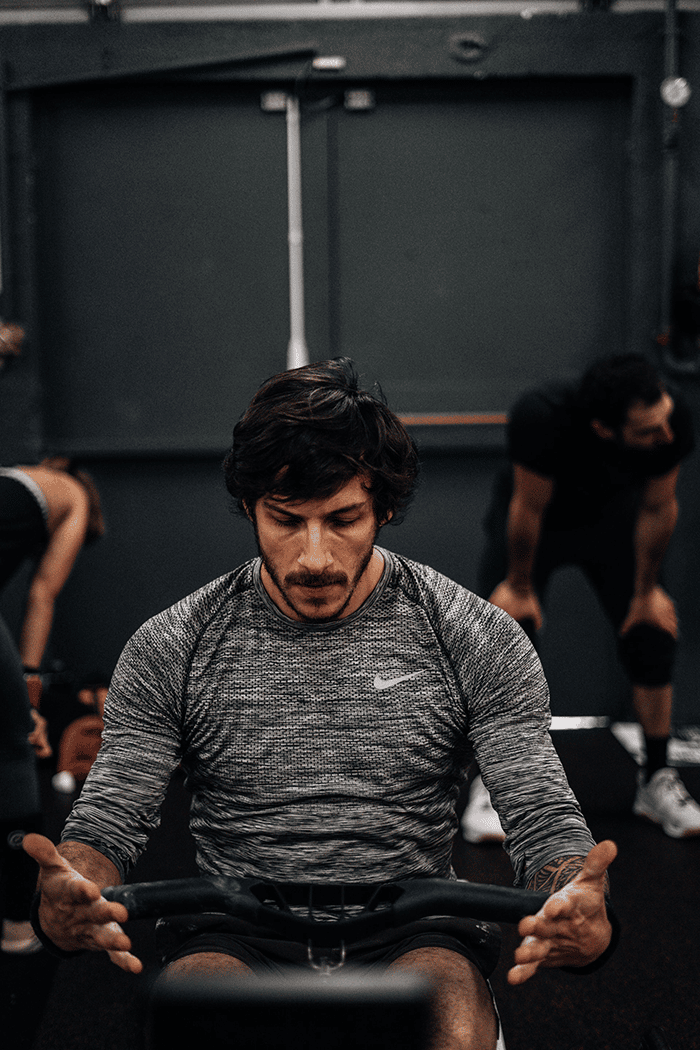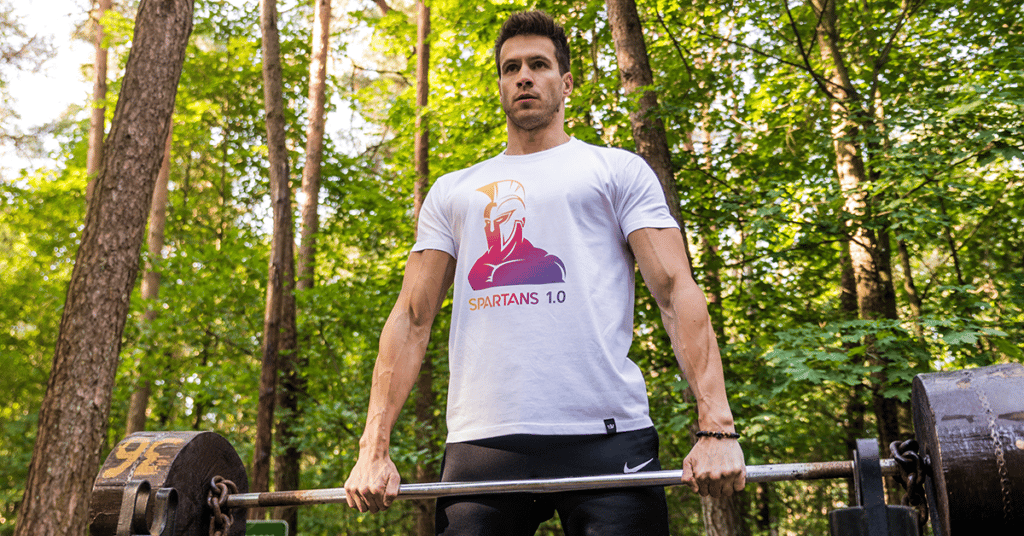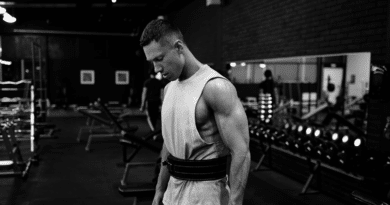How to Barbell Shrug – Benefits, Muscles Worked and Variations
This complete guide will teach you everything you need to know about the Barbell Shrug and why you should include them in your training.
What is the Barbell Shrug?
Barbell shrugs are a common weightlifting exercise that many people use to target their trapezius and improve the size and strength of their back, neck, and shoulders.
The exercise is commonly performed as a pull or back movement and can be used as an alternative to cable shrugs.
- What is the Barbell Shrug?
- What Muscles Does the Barbell Shrug Work?
- Why are Strong Lats Important?
- Why are Strong Traps Important?
- What are the Benefits of the Barbell Shrug?
- How to Do Barbell Shrugs with Perfect Technique
- How to Avoid Muscle Injuries While Performing Barbell Shrugs
- Common Mistakes with Barbell Shrugs
- Barbell Shrugs Variations
- Who Should Perform the Barbell Shrug?
- Does the Barbell Shrug Build the Neck Muscles?
- Are Barbell Shrugs for Beginners?
- How Much Weight Should I Use for the Barbell Shrug?
- Is the Barbell Shrug Right for Me?
- How Many Reps and Sets of Barbell Shrugs Should I do to Build Muscle?
- How Many Reps and Sets of Barbell Shrugs Should I do to Build Strength?
- Can I Do Shrugs with Dumbbells?
- Should You Go Heavy on Shrugs?
- What Grip should I Use for the Barbell Shrug?
- Are Barbell Shrugs a Good Exercise?
- Fitness Equipment
What Muscles Does the Barbell Shrug Work?
Before we get into the nitty-gritty of this exercise, let’s talk about which muscles it works. The barbell shrug is an upper body exercise that primarily targets the latissimus dorsi and trapezius. It also works your deltoid and rhomboid (upper back) muscles, as well as your levator scapulae (upper back).
You can perform the barbell shrug with either a straight or EZ-bar attachment, but it’s famous for its use of a trap bar. This actually isn’t a prerequisite: you can do this move with any straight bar, including a standard Olympic or powerlifting model.
Why are Strong Lats Important?
The latissimus dorsi is a large, flat muscle that runs along the mid-back and forms the majority of the back. It helps you row, pull, and reach. You perform these motions every day, whether you are doing simple activities like gardening or playing sports. Having strong lats will help make everyday tasks easier.

Why are Strong Traps Important?
Strong traps are important for a variety of reasons. Strong traps help improve posture, which helps prevent shoulder injuries, neck injuries and spinal injury. The traps stabilize the neck and the shoulders and are involved in movements that require strength, power and speed.
What are the Benefits of the Barbell Shrug?
The barbell shrug is a simple exercise that can help you to strengthen your traps and build muscle. The barbell shrug helps you to maintain a strong posture and can also improve your performance at other exercises.
Here are some of the benefits of incorporating the barbell shrug into your workout:
- Strengthens your traps
- Helps to prevent injury during other exercises
- Increases strength, helping you to perform better with weights
How to Do Barbell Shrugs with Perfect Technique
Barbell shrugs target your trapezius muscles, which are located at the back of your neck and upper shoulders. This exercise is meant to be performed with heavy weight. If you have a hard time holding onto the bar, try using lifting straps or wrist straps (available at most sporting goods stores).
Step 1: Position barbell on front of thighs
Stand up straight, with feet hip-width apart and knees slightly bent. Hold the barbell vertically in front of you with an overhand grip (palms facing down). The bar should rest on top of your thighs. Keep your chest up and back straight—don’t slouch forward as you hold the bar. This is your starting position.
Step 2: Hike shoulders towards ears and hold for a count
Keeping your chest up and back straight, hike both shoulders up towards your ears as high as possible. Hold this position for one count before returning to start position. Repeat for desired number of reps or sets

How to Avoid Muscle Injuries While Performing Barbell Shrugs
In order to avoid muscle injuries while performing barbell shrugs, you must make sure that your form is good. Here are some tips on how to keep yourself safe.
Your shoulders should be relaxed. Do not raise your shoulders higher than normal (i.e., do not tense them).
Your body position should be straight and upright. Your knees slightly bent, but your back should remain straight.
Keep your head in a neutral position. Do not look up or down or tilt it to one side or the other–with your chin tucked in just slightly so that you are looking forward without tilting your head back too much.
Do not rotate your shoulders at any point during the exercise; this will result in an injury if done incorrectly and/or too quickly!
The movement should come from raising upwards through the shoulder blades. Keep them stable do not allow them to rotate.
Common Mistakes with Barbell Shrugs
When performing barbell shrugs, it is vital that you avoid the following common mistakes:
Not keeping a Neutral Spine
For safety and to make sure you’re doing this exercise correctly, maintaining a neutral spine is important.
Not raising the Shoulders High Enough
To hit your traps well, make sure you raise your shoulders as high as possible.
Why you should use the Inverted Row
Not Holding the Contracted Position at the Top of the Lift
At the top of the lift, do not lower back down immediately.
Instead, hold for about 1 second and then slowly come back down. This will help build mass in your traps faster.
Not keeping the Shoulders Down and Relaxed between Reps
In order to relax and stretch out your upper body while not wasting energy on exercises that aren’t part of shrugs, keep your shoulders down as you perform this exercise.
Barbell Shrugs Variations
Here are some great variations.
- Shrugs with bands. You can put the band over your neck, or use a band that goes around your arms.
- Shrugs with a cable machine. You can use a rope attachment for this variation.
- Shrugs with dumbbells. Use wrist straps if needed so you don’t have to worry about grip strength. This also helps keep your focus on the traps and not the grip on the dumbbells.
- Snatch Grip Barbell Shrugs
Barbell Shrugs Alternatives
You can do Barbell Shrugs with dumbbells, a barbell, or a cable machine. If you don’t have any of these things and you’re looking for something else to do, there are some alternatives that use the same muscle groups.
- Dumbbell Front Raises
- Bumper Plate Front Raises
- Kettlebell Front Raises
Front Raises work the same muscles as Barbell Shrugs because they both target the front deltoids. They also activate your forearms and traps (which Barbell Shrugs only target in part).
Who Should Perform the Barbell Shrug?
As a trap and lats exercise, Barbell Shrugs are most effective for those looking to build muscle in their shoulders and back.
As such, they are a staple exercise for bodybuilders, powerlifters, and athletes who need to build bigger traps or stronger lats.
They’re also good for anyone who wants to develop a stronger neck or be more athletic.
Full-contact athletes like hockey players, rugby players, and American Football players all benefit from the extra strength that comes from shrugging heavy weights. This is particularly important for offensive linemen or hockey enforcers whose jobs involve many collisions with other players.
Athletes who play sports where balance is essential (like Olympic weightlifting) can perform shrugs on a single leg if playing around with unilateral loading is something they find interesting and beneficial.
Does the Barbell Shrug Build the Neck Muscles?
Barbell shrugs are not a direct neck exercise. They target the trapezius muscles, which are also referred to as “traps.” These large muscles in the back of your neck connect your shoulder blades and spine.
The trapezius muscles help you lift things, shrug your shoulders and turn your head. And common exercises that target this muscle group include barbell shrugs, upright rows and shoulder presses.
Important Training Equipment
Are Barbell Shrugs for Beginners?
Barbell shrugs are an excellent exercise for beginners and, with the proper form, are quite safe.
As discussed above, keeping a strong grip on the barbell means that there’s a minimal risk of dropping it on oneself.
So long as proper form is followed and one doesn’t try to lift more weight than he or she can handle, barbell shrugs can be used by anyone at any stage of their fitness journey.
There are two main muscle groups strengthened by performing barbell shrugs: the trapezius and the neck muscles. The trapezius is located along the upper back and shoulders, while your neck contains tons of tiny muscles that help keep your head upright throughout the day.
How Much Weight Should I Use for the Barbell Shrug?
When performing barbell shrugs, you should use a weight that is heavy enough to cause significant muscular fatigue within 8-15 repetitions.
If you are not feeling the exercise in your traps after 8 reps, increase the weight.
If you cannot perform more than 20 reps with proper form, decrease the weight.
Is the Barbell Shrug Right for Me?
Barbell shrugs are a great exercise for building up the back and neck areas.
If you’re someone who wants to bulk up those muscles, barbell shrugs are probably a good exercise for you.

How Many Reps and Sets of Barbell Shrugs Should I do to Build Muscle?
For muscle growth (hypertrophy), go for 3 – 5 sets of 8 – 12 reps. Rest for no longer than 45 seconds between sets.
It’s important not to go too heavy from the get-go in order to avoid injuring yourself. If you’re new to weight lifting, have someone check your form before increasing your weights.
How Many Reps and Sets of Barbell Shrugs Should I do to Build Strength?
You should perform shrugs for 4 – 6 sets of 3 – 6 reps with a heavy weight. Rest for at least two minutes between sets.
This is a relatively large amount of work, and your traps should be thoroughly fatigued by the end.
Can I Do Shrugs with Dumbbells?
Dumbbell shrugs can be a great alternative to barbell shrugs, and they’re also easier to learn. The three major benefits of barbell shrugs are:
- They allow you to load more weight than you can with dumbbells.
- They help improve your grip strength.
- They keep your wrists in a neutral position, which may reduce the risk of injury.
You can lift more weight with a barbell than with the same size weights held separately in each hand.
Should You Go Heavy on Shrugs?
With this exercise, it’s important to focus on the form and technique of the movement over lifting a heavy weight. Don’t let the ego get in the way.
If you’re new to shrugs, use a weight that you can lift with good form so that your shoulders are in a safe position throughout the exercise. Don’t sacrifice form for weight.
The heavier you lift, the more you risk injury and hitting your muscles too hard in order to grow them.
You will get stronger if you do the movement correctly.
What Grip should I Use for the Barbell Shrug?
There are three main ways to hold the barbell during shrugs:
- Double overhand grip
- Double underhand grip
- Mixed grip
The double overhand grip is best for beginners because it’s the least complicated.
Mixed grip is the easiest for holding the heaviest weights.
Are Barbell Shrugs a Good Exercise?
Yes. Barbell shrugs are good for you.
The main reason barbell shrugs are an excellent exercise is because they allow you to lift a lot of weight, and that makes them great for building muscle and strength.
Who will benefit from barbell shrugs? Powerlifters, bodybuilders, athletes, men, women, beginners, intermediate lifters and advanced lifters will all benefit from the barbell shrug exercise.




